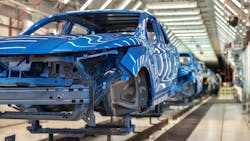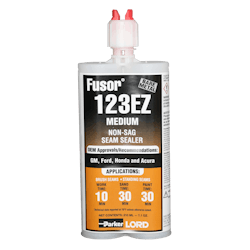Protect your bond: Navigating the effects of rising temperatures on adhesives
In the summer of 2023, the United States witnessed record-breaking heat waves that underscored a trend of increasingly hotter summers. This climatic shift not only challenges our daily comfort but also puts specialized products like adhesives under unprecedented strain. Adhesives play a critical role in various industries, particularly in automotive collision repair, where their application and strength are crucial. Understanding how extreme temperatures and humidity can impact adhesives is essential for maintaining their efficacy. Parker Lord explores the science behind adhesive performance in scorching conditions and provides a comprehensive guide to safeguarding your bonds against the summer heat.
Understanding the 2023 temperature surge
The summer of 2023 has been marked by extreme heat across the U.S., with temperatures frequently soaring above historical averages. According to the National Oceanic and Atmospheric Administration (NOAA), numerous regions experienced temperatures that exceeded the 90 degrees F mark, significantly affecting the performance and application of adhesives. This trend toward hotter summers is not new but reflects an ongoing climatic shift that demands adaptation and informed product usage.
Summer's toll on adhesives
Understanding how temperature and humidity affects adhesives is just as important as identifying the proper adhesives for your application.
High temperatures can drastically reduce working times, while elevated humidity levels can affect cure rates, especially in one-component products.
Adapting practices and selecting products with these factors in mind is a necessity to ensure durable repairs and applications.
Protecting your adhesives from the scorching summer heat
It's very important to always follow OEM product and procedure recommendations for all repairs done in the shop. Technicians should obtain proper repair information and product instructions and be aware of the impact the current temperature and humidity level will have on the outcome of the repair work.”
Assess and adapt to current conditions
Understanding and adapting to current environmental conditions is crucial for the effective use of adhesives. Therefore, it is vital to monitor temperature and humidity before commencing any adhesive-related work. This step is crucial, as it significantly influences the choice of adhesive products and the strategies for their application. Adhesives respond differently under varying climatic conditions; therefore, recognizing these variations and adjusting practices accordingly can be the difference between a successful bond and a failed application. This proactive approach not only ensures the longevity and durability of adhesive bonds but also enhances safety and efficiency during the application process.
Select the right product for the season
Selecting adhesives with extended work times for summer use, such as those in the Fusor 123 series, is critical for maintaining productivity and ensuring high-quality bonds in elevated temperatures. The unique formulations of these products are designed to counteract the rapid curing and setting processes accelerated by high heat. By opting for adhesives that cater to the specific challenges of summer heat, repair shops can mitigate the risks of premature curing, which could compromise the integrity and strength of the bonds. This thoughtful selection process allows for a more manageable and controlled application, ensuring that repairs and projects are completed successfully, even under challenging weather conditions.
Parker’s Fusor 123 series of non-sag seam sealers offer a range of work times suitable for varying climate conditions. The Fusor 123 series and each adhesive’s work times include:
- Fusor 123 Fast : 3-minute work time
- Fusor 123EZ Medium : 10-minute work time
- Fusor 123SL Slow: 45-minute work time
Store products properly
Proper storage of adhesives is paramount for maintaining their efficacy and longevity. Exposing adhesive products to inappropriate conditions such as excessive heat, direct sunlight, or high humidity can lead to premature curing, chemical degradation or compromised viscosity. These alterations can severely impact the adhesive’s performance, rendering it less effective or entirely unusable for its intended application. Additionally, moisture-sensitive adhesives can absorb ambient moisture if not stored correctly, which may trigger the curing process before application, leading to wasted material and financial losses. By adhering to the manufacturer's storage guidelines and investing in climate-controlled environments, professionals can prevent these adverse effects, ensuring that adhesives retain their optimal properties and performance levels. This diligence in storage not only safeguards the integrity of the materials but also contributes to efficient and reliable bonding outcomes in various projects.
Application techniques in high heat
In conditions of high heat, using proper application techniques becomes even more crucial for ensuring adhesive performance and longevity. The reduced working window necessitates precise and efficient application techniques to ensure a bond forms correctly before the adhesive sets. Techniques such as pre-cooling the substrates, adjusting the mix ratio of two-component (2K) adhesives to slightly delay the curing process and applying adhesives in shaded or temperature-controlled environments can significantly mitigate the effects of heat. Furthermore, the application of thin, uniform layers to clean surfaces can help control the exothermic reaction, which reduces the risk of overheating and premature curing. These techniques are not just about adapting to the heat but ensuring the reliability and durability of the bond under stress, making them indispensable in high-temperature conditions.
Adapt and overcome with technology and training
Staying informed through manufacturer training programs and maintaining direct communication with manufacturers are critical strategies for navigating the challenges of applying adhesives in extreme heat conditions. These proactive measures ensure that professionals are equipped with the latest knowledge and recommendations tailored to the unique demands of their projects and climatic challenges. Manufacturer training programs offer detailed insights into product capabilities, optimal application techniques, and adjustments required for different environmental conditions, enhancing both the efficacy and longevity of adhesive bonds.
Meanwhile, direct communication with manufacturers provides a channel for obtaining specific advice, troubleshooting unique issues and learning about the latest advancements in adhesive technology. Collaboration with manufacturers, informed selection of products and adherence to storage and application guidelines are pivotal in navigating the seasonal challenges.
Together, these approaches empower professionals to adapt their practices to the evolving challenges posed by climate change, ensuring that despite the rising temperatures, the quality and durability of adhesive applications remain uncompromised.
About the Author

Patrick Maloney
Patrick Maloney is the global sales and business development manager, Fusor Repair Adhesives, with Parker Lord (a subsidiary of Parker Hannifin Corporation)
Leif Hansson
Leif Hansson is a technical account manager for Parker Hannifin.



